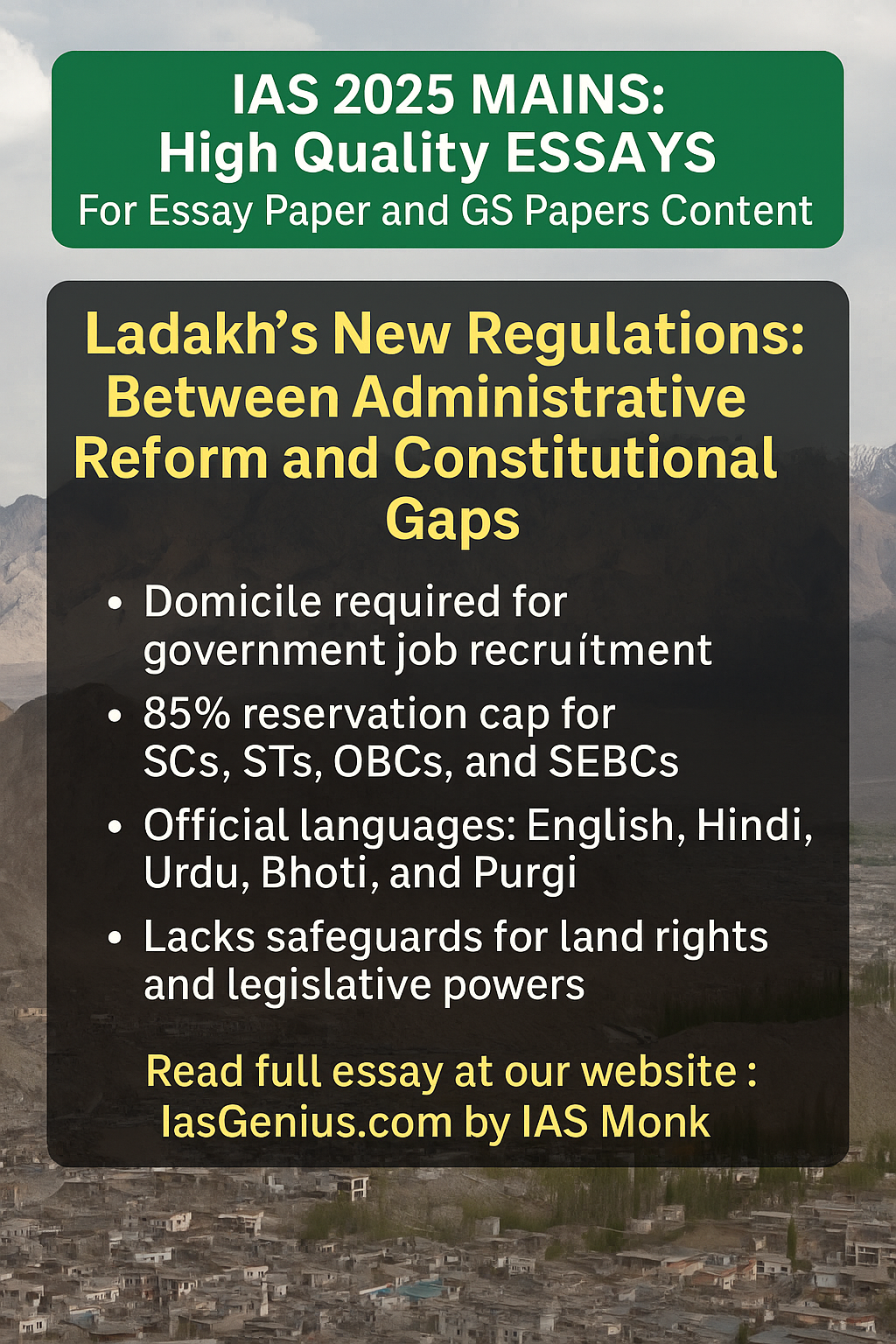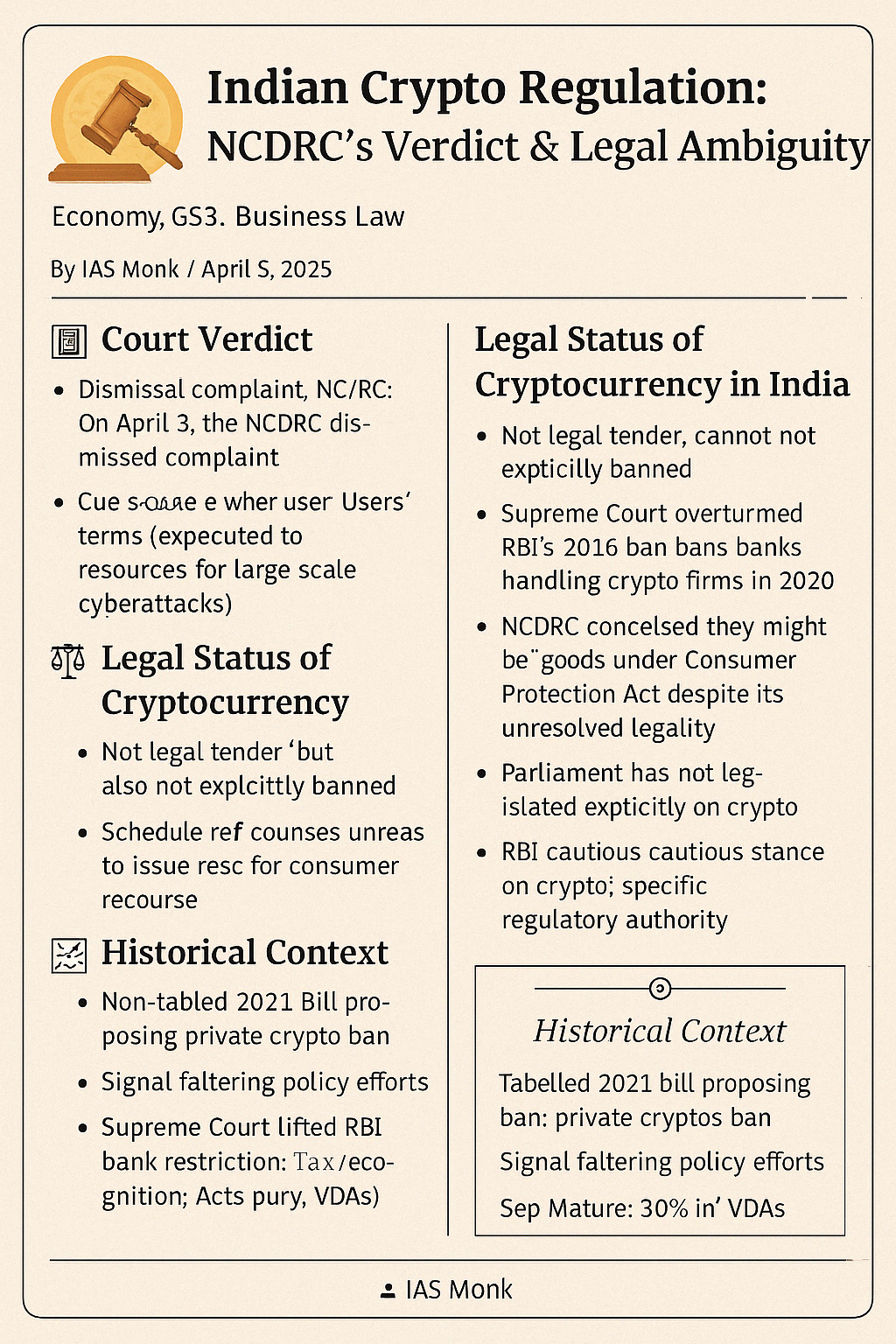
🧭June 5, 2025 Post 2: Ladakh’s New Regulations: Between Administrative Reform and Constitutional Gaps | High Quality Mains Essay | Prelims MCQs
🏔️ Ladakh’s New Regulations: Between Administrative Reform and Constitutional Gaps

GOVERNANCE –
Post Date: June 5, 2025
Focus: GS2 – Federalism | Domicile Policy | Sixth Schedule Demands
🕊️ Intro Whisper
In the land where glaciers whisper and mountains echo culture, governance now speaks a new dialect — one that promises protection, but stops short of permanence.
🔍 Key Highlights: What Has Been Notified?
- 🧾 Ladakh Civil Services (Amendment) Regulation, 2025
- Introduces domicile requirement for all government job recruitments.
- Domicile includes:
- 15-year residents
- Students who studied for 7 years and passed Class 10 or 12 from Ladakh
- Children/spouses of Central Govt staff serving 10+ years in Ladakh
- Children/spouses of Ladakh domiciles
- 📄 Domicile Certificate Rules, 2025
- Tehsildar as issuing authority, Deputy Commissioner as appellate body.
- Standardizes the process of verification for job eligibility and benefits.
- 📊 Reservation Amendment, 2025
- Caps reservation for SC, ST, OBC, and socially backward groups at 85%,
- Excludes 10% EWS quota, maintaining total within constitutional norms.
- 🗣️ Official Languages Regulation, 2025
- Recognises English, Hindi, Urdu, Bhoti, and Purgi as official languages.
- Offers institutional promotion to Shina, Brokskat, Balti, and Ladakhi.
- 👩💼 LAHDC (Amendment) Regulation, 2025
- Reserves one-third of Hill Council seats for women, through rotation.
🚫 Limitations & Local Concerns
| Concern | Issue Description |
|---|---|
| ❌ No Constitutional Status | Made under Article 240 — executive orders, not constitutional provisions. |
| 🏔️ No Land Protection | No restriction on non-domicile land purchase — feared demographic dilution. |
| 📜 No Legislative Powers | LAHDCs still lack the law-making authority that Sixth Schedule ADCs possess. |
| 🎭 Symbolic Language Use | No roadmap for actual implementation in education, judiciary, or bureaucracy. |
📚 Sixth Schedule: What Ladakh Demands But Hasn’t Received
- Applicable to tribal areas of Assam, Meghalaya, Tripura, Mizoram
- Grants legislative, judicial, administrative autonomy to Autonomous District Councils
- Councils can make laws on:
✅ Land, Forests, Customs, Policing
✅ Village Governance, Health, Property, Social Practices
✅ Tribes-only courts for minor offences (<5 years sentence)
🧭 GS Paper Mapping
| GS Paper | Theme | Subtopics |
|---|---|---|
| GS Paper 2 | Federal Structure | Centre-UT relations, Sixth Schedule, LAHDC |
| GS Paper 2 | Welfare & Governance | Domicile, Reservation, Cultural Preservation |
| GS Paper 4 | Ethics in Administration | Cultural Sensitivity, Equity, Institutional Trust |
🪔 A Thought Spark — by IAS Monk
“Protection on paper may soothe the day — but without roots in the Constitution, even the tallest mountain may feel unanchored.”
High Quality Mains Essay For Practice :
Word Limit 1000-1200
🟩 IAS 2025 MAINS: High Quality ESSAYS For Essay Paper and GS Papers Content
Ladakh’s Autonomy Debate: Domicile, Development and the Demand for Constitutional Safeguards
Introduction
Since its bifurcation from Jammu & Kashmir in 2019, Ladakh has emerged as a region at the intersection of administrative reform, identity assertion, and geopolitical sensitivity. The recent set of regulations notified by the Centre — addressing job reservations, language preservation, and domicile rules — reflects a long-awaited response to the demands of Ladakhi civil society. However, these administrative measures raise a larger constitutional question: Is executive benevolence enough to protect the socio-cultural and demographic identity of a fragile Himalayan frontier, or does Ladakh require deeper constitutional safeguards akin to the Sixth Schedule? This essay explores the implications of these reforms and their adequacy in securing Ladakh’s future.
Background: A Region in Transition
Ladakh became a Union Territory (UT) on August 5, 2019, after the revocation of Article 370. Unlike Jammu & Kashmir, Ladakh was not granted a Legislative Assembly. The region, comprising the Buddhist-majority Leh and Muslim-majority Kargil, was initially euphoric about its new status, expecting direct development intervention from the Centre.
However, the euphoria soon gave way to apprehension. Civil society groups, student bodies, and local leaders raised concerns over demographic change, job displacement, cultural erosion, and the absence of legislative safeguards. In particular, the demand for:
- Inclusion in the Sixth Schedule,
- Job and land protections,
- Separate parliamentary constituencies for Leh and Kargil, and
- Statehood for full-fledged democratic governance
gained momentum, culminating in coordinated protests and dialogues with the central government.
What Do the New Regulations Say?
The Centre has now notified a package of executive regulations under Article 240, which governs UTs without legislatures. The key highlights include:
🧾 Domicile-Based Recruitment
The Ladakh Civil Services (Decentralization and Recruitment) Regulation, 2025 introduces domicile as a requirement for government jobs. A person is considered a domicile if:
- They have resided in Ladakh for 15 years, or
- Studied for 7 years and passed Class 10 or 12 from Ladakh, or
- Are children/spouses of Ladakhis or Central Govt employees who served in Ladakh for 10+ years.
📜 Reservation Regulation
The Reservation Regulation, 2025 caps quotas for SCs, STs, OBCs, and other backward communities at 85%, exclusive of the 10% EWS quota. This aligns with the Supreme Court-mandated reservation ceiling and caters to the region’s tribal demographics.
🗣️ Language Recognition
The Official Languages Regulation, 2025 grants official language status to Hindi, Urdu, English, Bhoti, and Purgi, while recognizing Shina, Balti, Ladakhi, and Brokskat for cultural preservation.
👩💼 Women’s Representation
Through amendments to the LAHDC Act, 1997, one-third of seats in the Hill Development Councils (Leh & Kargil) will now be reserved for women, on a rotational basis.
Symbolic Gains, Structural Deficits: Key Criticisms
While these regulations mark progress, several critical limitations have emerged:
❌ No Constitutional Permanence
The regulations are executive in nature — issued under Article 240. They lack the durability of constitutional provisions and can be modified or repealed at the Centre’s discretion.
🏔️ No Land Safeguards
Unlike the Sixth Schedule or Article 371 provisions, these regulations do not restrict land ownership by outsiders. This raises fears of demographic dilution, unregulated tourism, and ecological stress.
🚫 No Legislative Autonomy
The Ladakh Autonomous Hill Development Councils (LAHDCs) remain advisory and administrative bodies, lacking the power to make binding laws — a key feature of Autonomous District Councils under the Sixth Schedule.
🗣️ Language Promotion Lacks Teeth
While multiple languages are recognized, there is no roadmap for their usage in official communication, education, or judiciary. This reduces the linguistic provisions to tokenism.
Sixth Schedule: What Ladakhis Really Want
The Sixth Schedule of the Constitution, applicable to certain tribal regions in Assam, Meghalaya, Tripura, and Mizoram, grants autonomous district councils (ADCs) the power to:
- Make laws on land, forests, agriculture, customs, and local governance
- Establish tribal courts for civil/criminal matters among STs
- Control revenue and local resources
- Frame rules on marriage, inheritance, and social norms
For a region with 80% tribal population, Ladakh is arguably eligible for similar protections. Inclusion under the Sixth Schedule would provide constitutional safeguards that cannot be undone without a constitutional amendment — unlike executive orders.
Why These Reforms Still Matter
Despite their limitations, the new regulations offer several important gains:
✅ Legal Recognition of Identity
Domicile requirements formally recognize Ladakhis as a distinct local category, prioritizing them for public employment and administration.
✅ Codification of Language Diversity
The linguistic recognition, even if symbolic, sets a foundation for future expansion into education, preservation, and inter-generational transmission of local cultures.
✅ Affirmative Action with Demographic Relevance
The reservation structure reflects ground realities where Scheduled Tribes (STs) form the majority. It strengthens representation in bureaucracy and ensures policy sensitivity.
✅ Gender Inclusion
Reserving seats for women in the LAHDCs is a progressive step toward inclusive governance in a region traditionally dominated by patriarchal hierarchies.
Balancing Autonomy and National Interest
Ladakh is not just a cultural zone — it is also a strategic frontier, sharing borders with China and Pakistan. The Indian government’s reluctance to offer full legislative autonomy or Sixth Schedule inclusion may stem from:
- Security considerations (sensitive military deployment)
- Need for central control in border zones
- Desire to avoid setting a precedent for other UTs or regions demanding similar privileges
However, this must be balanced with the aspirations of Ladakhi citizens, whose demands are rooted not in secessionism but in preservation and participation.
GS Paper Mapping
| GS Paper | Area | Subtopics |
|---|---|---|
| GS2 | Governance & Federalism | Centre–UT Relations, Sixth Schedule, Domicile, Reservations |
| GS2 | Welfare & Minorities | ST Rights, Women Representation, Language Inclusion |
| GS3 | Environment | Tourism pressure, Land degradation, Ecological vulnerability |
| GS4 | Ethics in Public Life | Cultural sensitivity, Justice, Democratic responsiveness |
The Way Forward: Toward Meaningful Autonomy
If the Centre is serious about “development with identity”, it must move beyond executive safeguards and pursue a dialogue-based constitutional roadmap, which could include:
- Inclusion in the Sixth Schedule, or a tailor-made provision under Article 371
- A UT Legislature for greater representation and law-making autonomy
- Special Land Protection Law to prevent indiscriminate sale of land to non-domiciles
- A Language Promotion Commission to institutionalize native languages in governance
- Annual Social Audit of affirmative action measures and domicile implementation
Conclusion
Ladakh’s journey from a picturesque frontier to a political hotspot encapsulates the tensions between national integration and local empowerment. The Centre’s new regulations represent an acknowledgment of Ladakhi aspirations, but not their fulfillment. In the absence of constitutional protection, these gains remain reversible.
The essence of governance in such ecologically fragile and culturally unique regions lies not just in allocating resources or issuing notifications, but in recognizing that identity, autonomy, and representation are foundational to stability. As the mountains stand still but the political winds shift, the need for trust-building constitutionalism has never been more urgent.
Target IAS-26: Daily MCQs :
📌 Prelims Practice MCQs
Topic: Ladakh
MCQ 1 – Type 1: How many of the above statements are correct?
Consider the following statements regarding the new regulations for Ladakh notified in 2025:
1. The domicile requirement for jobs includes persons who have studied for 7 years and passed Class 10 or 12 in Ladakh.
2. The total reservation for SC, ST, OBC, and other backward groups is capped at 95%.
3. Tehsildars are the issuing authority for domicile certificates.
4. Bhoti and Purgi are recognized as official languages of Ladakh.
How many of the above statements are correct?
A) Only two
B) Only three
C) All four
D) Only one
🌀 Didn’t get it? Click here (▸) for the Correct Answer & Explanation
✅ Correct Answer: B) Only three
🧠 Explanation:
•1) ✅ True – Studying for 7 years and passing Class 10 or 12 from Ladakh qualifies for domicile.
•2) ❌ False – Total capped at 85%, excluding EWS 10%, not 95%.
•3) ✅ True – Tehsildars issue domicile certificates; Deputy Commissioners serve as appellate authorities.
•4) ✅ True – Bhoti and Purgi are part of the official language list.
MCQ 2 – Type 2: Two Statements Based
Consider the following two statements:
1. The new rules were framed under Article 244 of the Constitution, granting Ladakh Sixth Schedule status.
2. The LAHDC amendment reserves one-third of the seats for women through rotation.
Which of the above statements is/are correct?
A) Only 1 is correct
B) Only 2 is correct
C) Both are correct
D) Neither is correct
🌀 Didn’t get it? Click here (▸) for the Correct Answer & Explanation
✅ Correct Answer: B) Only 2 is correct
🧠 Explanation:
•1) ❌ False – The rules were made under Article 240, not 244, and Ladakh is not under Sixth Schedule.
•2) ✅ True – The LAHDC Act was amended to provide 1/3rd reservation for women.
MCQ 3 – Type 3: Which of the statements is/are correct?
Which of the following statements correctly identify limitations of the new regulations in Ladakh?
The regulations are executive in nature and lack constitutional permanency.
There is no restriction on land ownership by outsiders.
The local official languages must be used mandatorily in judicial and governance processes.
LAHDCs still lack law-making powers.
Select the correct code:
A) 1, 2 and 3 only
B) 2, 3 and 4 only
C) 1, 2 and 4 only
D) All four
🌀 Didn’t get it? Click here (▸) for the Correct Answer & Explanation
✅ Correct Answer: A) 1, 2 and 3 only
🧠 Explanation:
•1) ✅ True – Made under Article 240, regulations can be changed by the Centre.
•2) ✅ True – No protection yet against non-domicile land acquisition.
•3) ❌ False – Languages are recognized, but no mandate for official/legal use.
•4) ✅ True – LAHDCs are administrative bodies, not legislative councils.
MCQ 4 – Type 4: Direct Fact
Under which Article of the Constitution were the 2025 Ladakh regulations enacted?
A) Article 244
B) Article 371
C) Article 240
D) Article 263
🌀 Didn’t get it? Click here (▸) for the Correct Answer & Explanation.
✅ Correct Answer: C) Article 240
🧠 Explanation:
•✅ Article 240 empowers the President to make regulations for Union Territories without legislatures. Ladakh is governed directly under this provision.


















